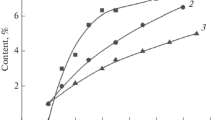Summary
-
1.
The phase structure of silicon-copper contact masses or the presence or absence of the intermetallic compound Cu3Si do not directly determine the selective activity of the masses in methylchlorosilane formation. At the same time, with alloy contact masses in which at the start of the synthesis all the copper is bound in the form of Cu3Si, the decay rate of the intermetallic compound is what determines the concentration and properties of the active catalyst (copper). In view of this, the properties of theη-phase play an important role in the total and selective activity of the catalyst in methylchlorosilane synthesis.
-
2.
Adding promoters or contact poisons changes the kinetics of the reaction between Cu3Si and methyl chloride (formation of copper catalysts), which is one of the reasons why they effect the catalytic activity of the alloys.
Similar content being viewed by others
Literature cited
S. A. Golubtsov, I. V. Trofimova, and N. P. Lobusevich, Transactions of the Conference on the Chemistry and Use of Silicon Organic Compounds [in Russian], No. 1, p. 41 (1958).
Ibid, No. 6, p. 28 (1961).
K. P. Lobusevich,S. A. Golubtsov, I. V. Trofimova, and N. A. Andrianov Zh. obshch. khimii,32, 841 (1962).
D. I. Lainer, L. A. Malysheva, and L. I. Sotnikova, Promotion of Silicon-Copper Catalysts by Antimony, Transactions of the Giprotsvetmetobrabotka Institute [in Russian], No. 20 (1961).
D. I. Lainer, L. A. Malysheva, and L. I. Sotnikova, Catalytic Poisons in Silicon-Copper Alloys, Transactions of the Giprotsvetmetograbotka Institute [in Russian], 20 (1961).
J. Joklic and V. Bazant, Coll.,26, 417 (1961).
V. D. Krylov, Ya. I. Babel', Yu. N. Efremov, A. M. Klenina, and S. L. Lel'chuk, Zh. fiz. khimii,33, 1954 (1959).
A. A. Klebanskii and V. S. Fikhgengol'ts, Zh. obshch khimii,26, 2502 (1956).
R. A. Turetskaya, I. V. Trofimova, K. A. Andrianov, and S. A. Golubtsov, Zh. obshch. khimii (in press).
L. P. Morozova, S. A. Golubtsov, K. A. Andrianov, I. V. Trofimova, and N. G. Morozov, Izv. AN SSSR, Old. khim. n., 1006 (1962).
V. D. Krylov and R. A. Turetskaya, Zh. obshch. khimii (in press).
Author information
Authors and Affiliations
Rights and permissions
About this article
Cite this article
Lobusevich, N.P., Lainer, D.I., Trofimova, I.V. et al. Formation of alkyl(aryl)chlorosilanes by direct reaction between alkyl(aryl)chlorides and silicon Communication 5. The phase stricture of silicon-copper contact masses in reactions with methyl chloride. Russ Chem Bull 12, 1613–1621 (1963). https://doi.org/10.1007/BF00845788
Received:
Issue Date:
DOI: https://doi.org/10.1007/BF00845788



